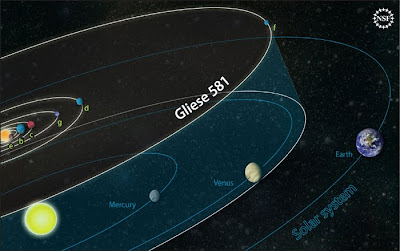Saturday, February 19, 2011
Still no Sign of Gliese 581g
For those of you unfamiliar with the process of finding distant exoplanets, the problem, is that the VAST majority of these objects cannot be observed directly, and even those few extrasolar planets which have been seen, are little more than dots and blurs. In other words, it's not as if we can just point an optical telescope in the planets direction and have a quick look to confirm it's presence. Instead, these distant objects are identified by observing changes in their parent stars, such as shifts in the intensity of the light being emitted by the star or "wobbles" in it's position. From this data, which is typically accumulated over a period of years to build a worthwhile data set, researchers are then able to estimate the size of the planet and the distance at which it orbits it's parent star.
Though the initial re-analysis conducted by the Swedish team did included an additional 2 years worth of observations made by the HARPS Spectrograph in Chile, it did not include data collected by the HIRISE spectrograph in Hawaii. And because the American team used a combination of these two data sets in their research, it's entirely possible that the planet's existence can only be confirmed using both sets. Which is why in January of this year, astro-statistics expert Phillip Gregory of the University of British Columbia, published the first re-analysis of the combined data sets. The results, he too has been unable to confirm the initial observation and has concluded that they were most likely based on statistical error.
While Gregory's findings certainly don't help the case for 581g, that doesn't mean the planet is officially down and out, as subsequent analysis of the data could easily tilt the scales the other direction. As for a final word on the existence of the planet, even if the next study confirms the initial findings, it will likely be years before the planet is either officially accepted or rejected by the scientific community. Hey, no one ever said science was fast.
-CAINE-
Source: wired science
Image credit:Zina Deretsky
Subscribe to:
Post Comments (Atom)




No comments:
Post a Comment